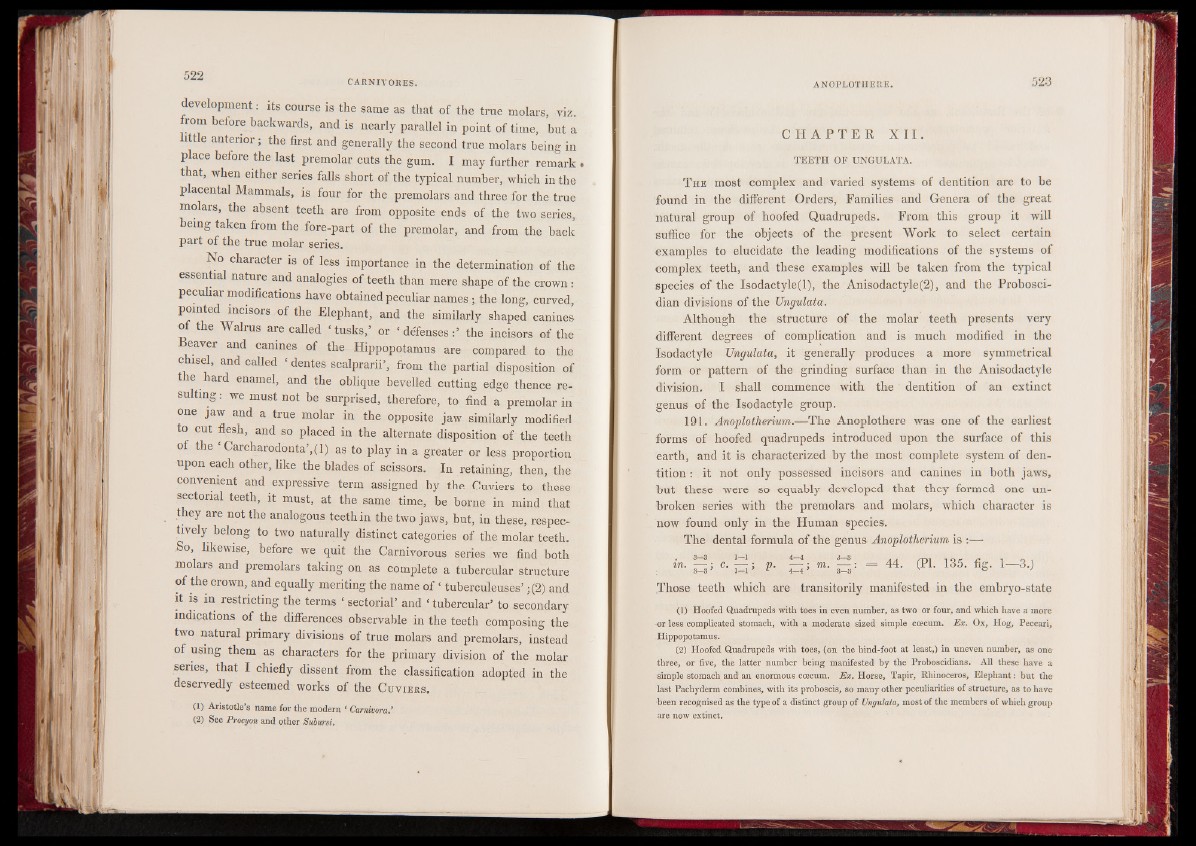
CARNIVORES.
development: its course is the same as that of the true molars, viz.
rom before backwards, and is nearly parallel in point of time, but a
little anterior; the first and generally the second true molars being in
place before the last premolar cuts the gum. I may further remark .
that, when either series falls short of the typical number, which in the
placenta] Mammals, is four for the premolars and three for the true
molars, the absent teeth are from opposite ends of the two series,
being taken from the fore-part of the premolar, and from the back
part of the true molar series.
No character is of less importance in the determination of the
essential nature and analogies of teeth than mere shape of the crown:
peculiar modifications have obtained peculiar names ; the long, curved,
pointed incisors of the Elephant, and the similarly shaped canines
of the Walrus are called ‘tusks,’ or ‘ defensesthe incisors of the
eaver and canines of the Hippopotamus are compared to the
chisel, and called ‘ dentes scalprarii’, from the partial disposition of
the hard enamel, and the oblique bevelled cutting edge thence resulting
: we must not be surprised, therefore, to find a premolar in
one jaw and a true molar in the opposite jaw similarly modified
to cut flesh, and so placed in the alternate disposition of the teeth
of the ‘ Carcharodonta’,(l) as to play in a greater or less proportion
upon each other, like the blades of scissors. In retaining, then, the
convenient and expressive term assigned by the Cuviers to these
sectorial teeth, it must, at the same time, be borne in mind that
they are not the analogous teeth in the two jaws, but, in these, respectively
belong to two naturally distinct categories of the molar teeth.
So, likewise, before we quit the Carnivorous series we find both
molars and premolars taking on as complete a tubercular structure
of the crown, and equally meriting the name of ‘ tuberculeuses’ ;(2) and
it is in restricting the terms ‘ sectorial’ and ‘ tubercular’ to secondary
indications of the differences observable in the teeth composing the
two natural primary divisions of true molars and premolars, instead
of using them as characters for the primary division of the molar
series, that I chiefly dissent from the classification adopted in the
deservedly esteemed works of the C u v ie r s .
(1) Aristotle’s name for the modern ! Carnivora.’
(2) See Procyon and other Subursi.
ANOPLOTHERE. 523
C H A P T E R X I I .
TEETH OF UNGULATA.
T h e most complex and varied systems of dentition are to be
found in the different Orders, Families and Genera of the great
natural group of hoofed Quadrupeds. From this group it will
suffice for the objects of the present Work to select certain
examples to elucidate the leading modifications of the systems of
complex teeth, and these examples will he taken from the typical
species of the Isodactyle(l), the Anisodactyle(2), and the Proboscidian
divisions of the Ungulata.
Although the structure of the molar teeth presents very
different degrees of complication and is much modified in the
Isodactyle Ungulata, it generally produces a more symmetrical
form or pattern of the grinding surface than in the Anisodactyle
division. I shall commence with the dentition of an extinct
genus of the Isodactyle group.
191. Anoplotherium.—The Anoplothere was one of the earliest
forms of hoofed quadrupeds introduced upon the surface of this
earth, and it is characterized by the most complete system of dentition
: it not only possessed incisors and canines in both jaws,
but these were so equably developed that they formed one unbroken
series with the premolars and molars, which character is
now found only in the Human species.
The dental formula of the genus Anoplotherium is :—
m. . 3——3 ; c. -1——1 4—4
4—4 1 44. (PI. 135. fig. 1—3.j
Those teeth which are transitorily manifested in the embryo-state
(1) Hoofed Quadrupeds with toes in even number, as two or four, and which have a more
•or less complicated stomach, with a moderate sized simple cæcum. Ex. Ox, Hog, Peccari,
. Hippopotamus.
(2) Hoofed Quadrupeds with toes, (on the hind-foot at least,) in uneven number, as one
three, or five, the latter number being manifested by the Proboscidians. All these have a
simple stomach and an enormous coecum. Ex. Horse, Tapir, Rhinoceros, Elephant : but the
last Pachyderm combines, with its proboscis, so many other peculiarities of structure, as to have
been recognised as the type of a distinct group of Ungulata, most of the members of which group
are now extinct.